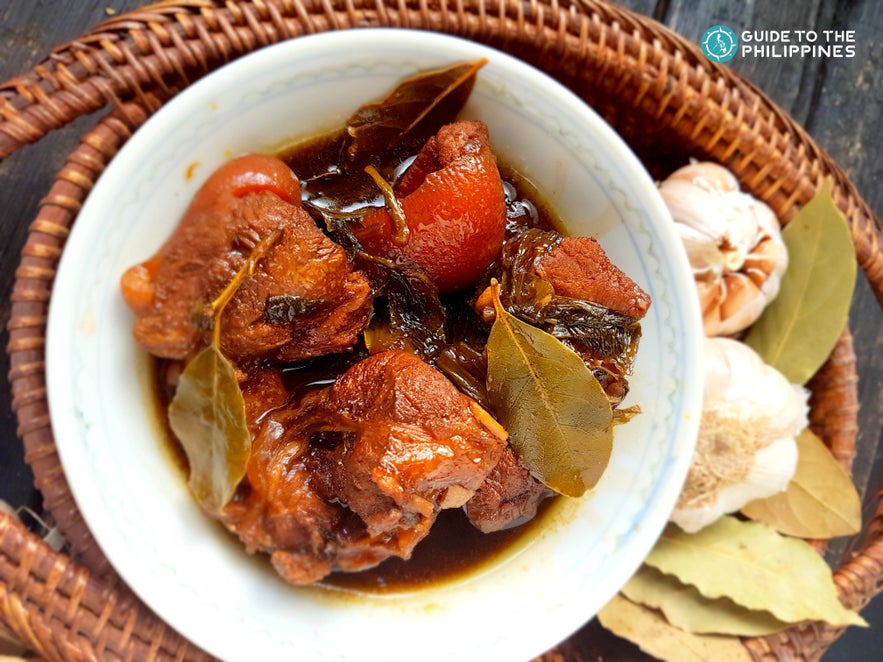
It would be tremendously difficult to talk about Filipino food and not talk about adobo. In every corner of the country (plus in every city around the world a Filipino resides in), adobo, in one form or another is served and enjoyed.
No trip to the Philippines is complete without eating the classic adobo or any of its variation either in a Filipino household, restaurants, or culinary tours.
Here is a guide to discover what exactly it is, it’s history, the basics on making a proper adobo, and what kinds you should definitely try!
What is Adobo?
![]() Essentially, adobo is a stew, where the main ingredient, usually a protein of some sort, is braised in vinegar, peppercorns, and bay leaves.
Essentially, adobo is a stew, where the main ingredient, usually a protein of some sort, is braised in vinegar, peppercorns, and bay leaves.
Probably the first Filipino dish to enter the foreign consciousness, adobo is so ingrained in Philippine culture that the running joke is that there are probably as many versions of adobo as there are islands in the Philippines (more than 7,100 during low tide).
Empirically speaking, there may be more, since almost every Filipino family around the world has their own relatively unique version of this dish.
The name “adobo” actually is the cause of a lot of confusion surrounding this dish. Because both Spanish and Mexican cuisines use the term adobo as well, some mistake the Filipino adobo to have been borne of their influence.
Further studies, however, have proven that this is simply not the case. The Filipino adobo is completely unique and based on accounts, was given this name only because the Spanish colonizers didn’t know of this dish, and therefore assigned a familiar name to it for easier recognition.
As with most Filipino dishes, different versions of a dish have emerged based on the availability of ingredients and geography. Don’t be surprised if every trip to a different region in the Philippines will yield a new version of adobo.
The Basic Adobo Process
![]()
Before learning about the different variations, it’s best to get the basics down pat first.
1. Choose Your “Protein"
There are no rules when choosing what to cook for adobo. Pork and chicken are the most common versions, but squid, beef, quail, duck, pork or chicken livers and even chicken feet are quite common too.
Protein isn’t even a requirement as bamboo shoots, tofu and kang kong (water cabbage/spinach) can be used as well.
2. Add the Essentials
Vinegar is the most important ingredient in adobo and the kind of vinegar used depends largely on the maker’s taste but also the region they reside in.
Among the most common vinegars used range from coconut to distilled white to sugar cane or even sugar palm. Meanwhile, the other essentials include whole black peppercorns and bay leaves (locally called “dahon ng laurel”).
As with most Filipino dishes, onions and garlic are also a part of most adobo recipes.
3. Flavor Pack
An important decision in making adobo is to choose what to use to salt the dish. The most common ingredient used is soy sauce, but fish sauce and sea salt are other wholly acceptable alternatives as well.
4. The Marination Equation
Filipino cooks are rather split on this. Some believe that marinating the protein in the vinegar and other ingredients is the key to a more flavorful adobo. Others prefer to forego this step and go straight to the braising process.
5. To Dry or Not to Dry
The last decision to make when cooking adobo is the level of moisture to be left in the dish. Some regions, particularly the Visayas region, prefer to cook the adobo until the braising liquid is completely evaporated, leaving the protein to fry in the oil remaining, crisping it up.
The most common version leaves a little bit of the braising liquid, and that serves as the sauce that can be used to flavor the steamed rice one enjoys the adobo with.
7 Common Adobo Variants to Try
With so much adobo variants, where do you start? Here's 7 of the best and must-try adobo dishes that you should try:
Chicken Pork Adobo
![]()
Photo by Via Mare
This is the most commonly found version around the Philippines. Chicken and pork meat are braised in vinegar, soy sauce, garlic, onions, peppercorns, and bay leaves.
What results is a rich stew, made savory by the soy sauce and brightened by the vinegar. These strong flavors are then tempered by the earthy flavors of the bay leaves and whole peppercorns.
Chef’s Tip: It’s not just an old saying. Adobo, particularly the long stewed ones that feature meat, are indeed more delicious on the 2nd or 3rd day.
Adobong Puti
![]()
Photo by Maggi
Many believe this is the purest or original form of the adobo, where the stew is flavored with sea salt instead of soy sauce. The resulting stew color is, of course, a light shade of brown, giving it its name. “Puti” is the Filipino word for white.
This version actually has a brighter, stronger acidity, as the vinegar is not tempered by the flavors of the soy sauce.
Chef’s Tip: It isn’t as easy to find this version in a restaurant, but a lot of households, probably in the Visayas region, still make this version.
Adobo sa Gata
Photo by Luna J Filipino Gastropub
The basic adobo flavors are given a richer and creamier boost. The addition of coconut milk actually helps temper the acidity of the dish, and most often, chilies are also added to give the dish an even more balanced flavor profile.
Chef’s Tip: It is most probably easier to find this version in the Southern Luzon area where coconut milk and chilies are quite common.
Adobo sa Dilaw
![]()
Photo by Pepper.ph
A favorite in the province of Batangas, the basic adobo is infused with the flavor and fragrance of turmeric, often referred to in Filipino as “luyang dilaw” (yellow ginger).
The resulting yellow color is preserved as most versions replace the soy sauce with sea salt, patis (fish sauce), or both. The subtle hints of turmeric do give a nice dimension to the sour adobo, giving it a depth of flavor.
Chef’s Tip: This version is also quite popular in Cavite, as the wife of national hero Emilio Aguinaldo was from Batangas and she was said to have brought her recipe to the province. It soon became a favorite in her adoptive province as well.
Adobong Pula
![]()
Photo by SPOT.ph
This time, adobo is tinted red (“pula” in Filipino) with the addition of water (or sometimes oil) that’s been mixed with atsuete (annatto seeds). While it doesn’t affect the flavor too much, most versions do come less salty and with a touch of sweetness.
Chef’s Tip: While this version is mostly attributed to the Ilonngo region, it can also be found in several other areas in the Philippines.
Adobong Pusit
![]()
Photo by Crisostomo Restaurant
This unique adobo recipe uses the squid in all its glory, including the ink. What results is a beautifully black adobo, still sour with the vinegar, but it also has a deep ocean flavor from both the squid meat and the ink.
Chef’s Tip: While the original version usually uses baby squid, more and more restaurants are using larger squids, to get more tender pieces.
Adobong Kang Kong
![]()
Photo by Ang Sarap
The most common non-meat version of adobo, it is also sometimes referred to as Apan Apan. Kang kong (water spinach) is stir-fried quickly with vinegar, soy sauce, garlic, and onions.
While it is not as hearty as the other adobo variants, it does evoke the same sour flavor profiles. It makes for an excellent side dish to grilled pork or chicken.
Chef’s Tip: This is easily a great dish for vegans. Just make sure they use vegetable oil and not pork lard when they stir fry the vegetables.
3 of Adobo’s Cousins
There are some dishes that are sometimes referred to as adobo, but they are actually different dishes. Here are 3 of the more popular ones.
Pininyahang Adobo
![]()
Photo by Kawaling Pinoy
Chicken or pork stewed with soy sauce and pineapple or pineapple juice is actually more classically known as “Pininyahan” or “Hamonado,” but whatever the name, they are still delicious.
The pineapples give the stew a sweet and sour flavor. It’s not quite adobo, but delicious nonetheless.
Chinese Adobo
![]()
Photo by Sentro 1771
It’s actually a dish more classically known as “Humba.” A Filipino version of the Chinese dish “Hong Ba,” pork is also stewed in soy and vinegar, but also star anise, fermented bean curd, sugar and sometimes even cinnamon.
Most versions also add banana blossoms to add more texture to the dish. Other versions feature stewed chicken feet and hard-boiled eggs.
Pata Tim
![]()
Photo by Balay Dako
An offshoot of the humba, pork leg (pata) is stewed with the same ingredients, usually with the addition of shitake mushrooms and sometimes bokchoy.
The meat is cooked so tender that it shreds and these shreds are sometimes placed in between steamed buns to make a most decadent sandwich.
The Inevitability of Adobo
![]() Whenever people talk about being homesick, food is often one of the first things people talk about. For thousands of homesick Filipinos working around the world, a bowl of adobo served with steaming hot rice is the piece of home they desperately crave for.
Whenever people talk about being homesick, food is often one of the first things people talk about. For thousands of homesick Filipinos working around the world, a bowl of adobo served with steaming hot rice is the piece of home they desperately crave for.
Why not? Everything about the adobo, from the sour and salty flavors to the fact that it’s best enjoyed with the family, is what Filipinos are all about. Have you truly been to the Philippines if you haven’t had adobo? That may be a rhetorical question.












